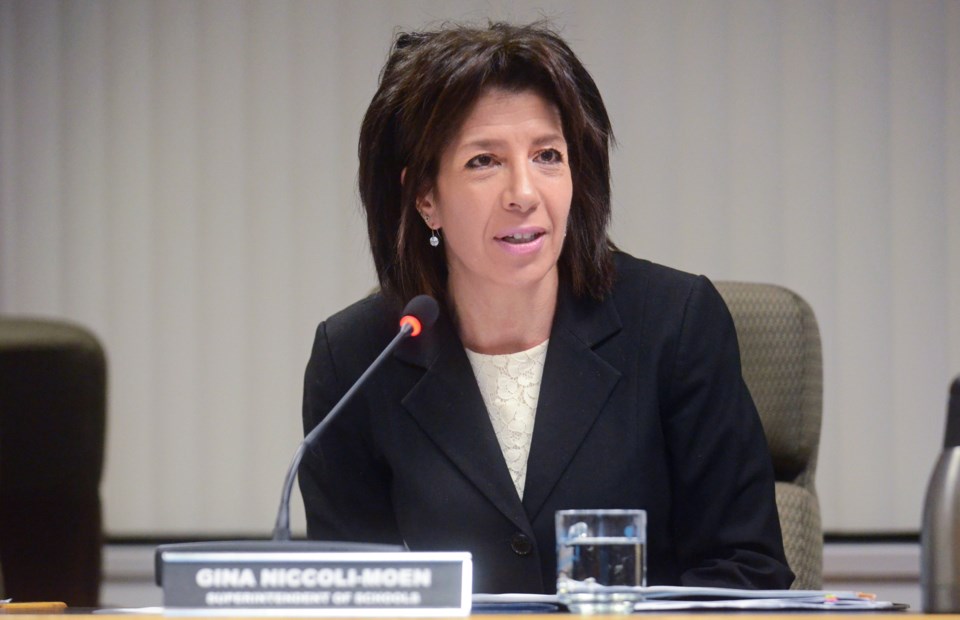With a new provincial curriculum, numerous building projects and a search for a new secretary treasurer all ahead, the Burnaby school district is looking down the barrel of another busy year, but superintendent Gina Niccoli-Moen is brimming with optimism.
“We’re ready, we’re excited, we’re good to go,” she told the NOW earlier this month. “It’s going to be an awesome year.”
Unlike the Vancouver district, which faces school closures because of dropping enrolment, Burnaby’s public school population is holding steady, and could even be higher than projected, but the numbers won’t be finalized until Sept. 30.
“Our kindergarten numbers seemed very strong when we looked at them at the end of June, but we cautiously watch until we actually see the families that come,” Niccoli-Moen said.
New curriculum
The new curriculum, which emphasizes tapping into students’ interests and encouraging critical thinking, collaboration and communication skills, becomes official this year for kindergarten to Grade 9 students and next year for students in grades 10 to 12.
Local teachers are particularly well poised for the new challenge, according to Niccoli-Moen, because of a longstanding tradition the district has of building partnerships in the broader community.
“That has been a part of who we are, so, for us, it’s that validation of that but it’s also that permission to take that leap and say, ‘What else is possible?’” she said.
A couple new programs being launched this year are cases in point.
At Burnaby North, Grade 9 to 11 students can now opt into a new program called ReThink – a “school within a school” in which students work with community partners, like the City of Burnaby, SFU, BCIT and the Burnaby Board of Trade, on real-life proposals, projects and problems based on the students’ interests.
At Moscrop, a new health sciences program will give students extensive use of BCIT labs and facilities as well as advanced credit for a BCIT course.
New CFO
At the school district office, meanwhile, a replacement has yet to be found for secretary-treasurer Greg Frank, who left the district after 16 years at the end of July for a job with the Surrey district.
The school board originally planned to have his replacement installed by the start of the school year.
“The board is in the middle of an executive search and that will be continuing on through September,” Niccoli-Moen said. “As we make our way through that process, we’ll certainly be relying on our finance team to pick up when Greg Frank left.”
Assistant secretary-treasurer Roy Uyeno helped wrap up the district’s annual external financial audit during the summer and will continue to head up the finance department until a new secretary-treasurer is hired.
“I came back, and it was all hands on deck,” Uyeno said of his return from a summer vacation.
New construction
On the building front, a $27.2-million seismic upgrade and partial replacement of Alpha Secondary continues, with the demolition of a six-classroom block imminent.
The next step will be the construction of a new classroom block, “super lab” and library.
To house students until that part of the project is complete, extra classrooms have been built into the existing school buildings.
The Alpha project is scheduled for completion in fall 2018.
A seismic upgrade and four-classroom addition at Montecito, meanwhile, won’t likely get shovels in the ground until next month, according to facilities manager Russ Sales.
That project was delayed when bids from general contractors came back higher than the budget allowed.
“We’ve now had to go a different route, which is having a construction management team come in and run the project for us in our best interest to try and lower the price,” Sales said.
Two other seismic upgrades in the district – at Stride Community School and Burnaby North Secondary – are still in the project development report stage.
Like with the Alpha project, Sales said the district hopes to convince the education ministry that a partial replacement of Burnaby North would be more practical than a pure seismic upgrade.
“All they’re funding for is a pure seismic upgrade, so even at Alpha we had to prove out that we could do the partial (replacement) more effectively than doing a pure seismic, which means that temporary buildings didn’t have to come on site to do that, how we changed the phasing to work that,” Sales said. “We’re going to run the same approach to the ministry on that of course. Whether or not it pans out is a little early to say.”
Besides big capital projects, the district’s facilities team was busy for more than 40 days during the summer working on projects like heating and ventilation upgrades, exterior paint jobs, roofing upgrades, LED lighting upgrades and playground installations.
Many of the upgrades will lead to energy and carbon neutral savings down the road, according to Sales.



